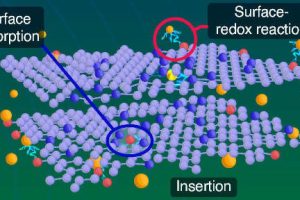Red phosphorus is a potential anode material for lithium-ion and sodium-ion batteries, but like sodium itself, its positive values are counter-balanced by considerable challenges. Academics in China and Poland have done a detailed systematic review of phosphorus anode research, which has been published for anyone to read. “The development of cost-effective and high-performance red phosphorus anode materials for Li-ion and ...
Tag Archives: sodium-ion
Novel carbonaceous anodes prolong sodium ion battery life
Researchers from Korea and USA have developed an anode for sodium-ion batteries which can still store energy after 1,000 charge-discharge cycles, claims Pusan National University, which worked with the University of Illinois at Urbana Champaign. While sodium is cheaper than lithium, and sodium ion cells can theoretically store plenty of energy, potential electrode materials are not proving equal to the ...
A stable anode for sodium-ion batteries?
Sodium-ion batteries could be a lower-cost alternative to Li-ion batteries, if ways are found to prevent the large sodium ions destroying their electrodes as they shuttle back and forth. As a possible sodium-ion anode for such batteries, materials scientists at Qingdao University have used titanium dioxide and graphite to produce a stable structure, unchanged after 2,000 cycles. “The researchers found ...
Nitrogen doping helps make a stable anode for sodium ion batteries
Sodium-ion technology would be a cheaper alternative to lithium-ions for batteries, if only its propensity to self-destruct could be tamed. Advances are being made in small steps, the latest of which is an anode material from the Korea Maritime and Ocean University which has kept working through 11,000 charge-discharge cycles at 100A per gram. One of the reasons for sodium-ion ...
Super computer finds sodium-ion battery molecule, that staggers at the last hurdle
In the dreams of battery makers, someone gets sodium-ion chemistry to work properly, and lithium it gets replaced with a cheaper more capacious metal. In the real world, sodium ions destroy the surrounding battery structure as they move in and out during use, catastrophically reducing cycle life compared with lithium-ion cells. Using a supercomputer to study the crystal structure of ~4,300 ...
Room-temperature flow battery uses liquid sodium-potassium alloy
Researchers at Stanford University have proposed liquid sodium-potassium alloy as an electron donor in a flow battery. Instead of storing electrons within the structure of a battery, a flow battery stores electrons in the form of chemicals in tanks, which are pumped into an electrolytic cell when charge or discharge is required. The action decouples power and energy storage, which ...
UK firms to develop Na-ion batteries
Faradion of Sheffield and Caithness battery make AGM Batteries have agreed to commercialise sodium-ion (Na-ion) batteries. Sodium is proposed as a cheaper alternative to relatively-rare lithium in rechargeable cells. “it is expected that sodium-ion batteries will also cost around 30% less to produce compared to conventional lithium ion technologies,” said Faradion, which has sodium ion intellectual property. One of the ...
Na-ion cathode is robust
Sodium-ion (“Na-ion”) batteries could have taken another step to practicality as “safe and sustainable” cathode material is invented at the University of Texas at Austin. The material is the the non-toxic and inexpensive mineral eldfellite (NaFe(SO4)2). “At the core of this discovery is a basic structure for the material that we hope will encourage researchers to come up with better ...
 Electronics Weekly Electronics Design & Components Tech News
Electronics Weekly Electronics Design & Components Tech News







